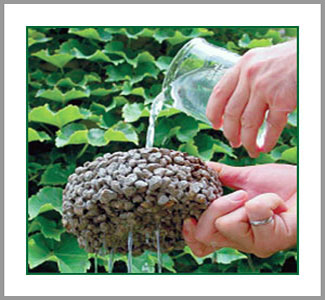Pervious Concrete Pavement
An Overview
Pervious concrete pavement is a unique and effective means to address important environmental issues and support green, sustainable growth. By capturing stormwater and allowing it to seep into the ground, porous concrete is instrumental in recharging groundwater, reducing stormwater runoff, and meeting U.S. Environmental Protection Agency (EPA) stormwater regulations. In fact, the use of pervious concrete is among the Best Management Practices (BMPs) recommended by the EPA—and by other agencies and geotechnical engineers across the country—for the management of stormwater runoff on a regional and local basis. This pavement technology creates more efficient land use by eliminating the need for retention ponds, swales, and other stormwater management devices. In doing so, pervious concrete has the ability to lower overall project costs on a first-cost basis.
In pervious concrete, carefully controlled amounts of water and cementitious materials are used to create a paste that forms a thick coating around aggregate particles. A pervious concrete mixture contains little or no sand, creating a substantial void content. Using sufficient paste to coat and bind the aggregate particles together creates a system of highly permeable, interconnected voids that drains quickly. Typically, between 15% and 25% voids are achieved in the hardened concrete, and flow rates for water through pervious concrete are typically around 480 in./hr (0.34 cm/s, which is 5 gal/ft²/ min or 200 L/m²/min), although they can be much higher. Both the low mortar content and high porosity also reduce strength compared to conventional concrete mixtures, but sufficient strength for many applications is readily achieved.
While pervious concrete can be used for a surprising number of applications, its primary use is in pavement. This site focuses on the pavement applications of the material, which also has been referred to as porous concrete, permeable concrete, no-fines concrete, gap-graded concrete, and enhanced-porosity concrete.
![]() See Green Building Technology in use at St Anne's Belfield Middle School, VA: Click on "Green Features"
See Green Building Technology in use at St Anne's Belfield Middle School, VA: Click on "Green Features"
A joint project between Allied Concrete and VRMCA.
![]() Science Museum of Virginia Rainkeeper Video
Science Museum of Virginia Rainkeeper Video
Virginia’s leading science museum has created a permanent indoor exhibit water management, supported by demonstrations and examples on the museum grounds including pervious concrete. Roanoke Cement, a Titan America company, provided support to museum to ensure strong representation for pervious. Museums such as this provide ongoing education to state residents and especially help children get an early understanding of how applications such as pervious concrete are of benefit to their lives and world.

The program is designed to be administered locally by local sponsoring groups in conjunction with planned training sessions or demonstrations of pervious concrete placement. NRMCA provides certification exams and performance evaluations to approved local sponsoring groups for administering the certification.
 NRMCA Specifier Webinars
NRMCA Specifier WebinarsContinuing Education for Architects, Engineers, Developers and Owners
![]() NEW! ACI 330 R-08 – The Gold Standard of Concrete Parking Lot Design
NEW! ACI 330 R-08 – The Gold Standard of Concrete Parking Lot Design
![]() Earning LEED® Credits by Utilizing Ready Mixed Concrete
Earning LEED® Credits by Utilizing Ready Mixed Concrete
Take a detailed look at the growing role played by ready mixed concrete in green building design and construction, including an overview of the LEED Green Building Rating System.
![]() The Quantifiable Advantages of Concrete Parking Lots
The Quantifiable Advantages of Concrete Parking Lots
With a free copy of NRMCA's Concrete Pavement Analyst (CPA) software, learn to produce detailed life-cycle cost comparisons of concrete and equivalent asphalt pavement designs.
![]() Designing and Specifying Pervious Concrete
Designing and Specifying Pervious Concrete
(Two-part Webinar)
Learn about pervious concrete pavement systems, engineering properties and construction techniques, including specifics to consider when drafting pervious concrete specifications.
These Webinars are AIA—registered and earn Professional Development Hours for participants.


